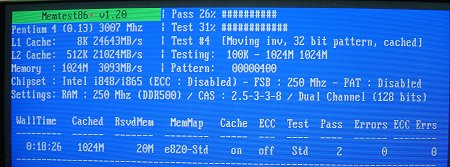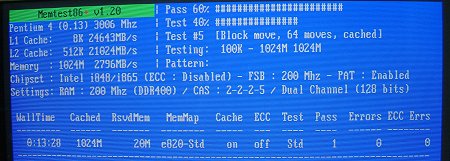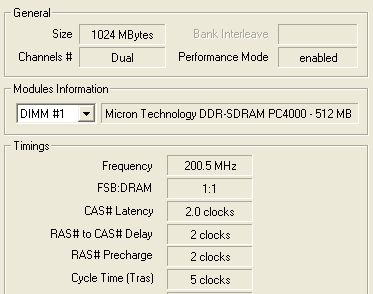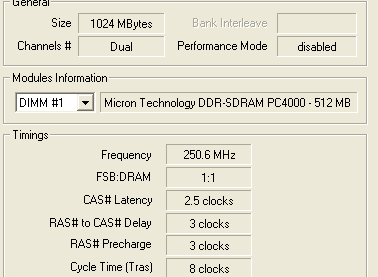System setup and notes
Hardware
- Crucial 1GByte Ballistix PC4000 RAM (2x512MB)
- Intel Pentium 4 3.4GHz ES Northwood CPU
- NVIDIA GeForce 6800 GT 256MB, 8x AGP, 350/1000
- DFI LANPARTY 865PE Springdale motherboard, run in both PAT-enabled and non-PAT-enabled modes
- Samcheer 420w PSU
- Intel reference cooler
- WD 160JB 160GB hard drive (PATA)
- Dell P991 19" flat-faced CRT monitor
Software
- Windows XP Professional w/SP1
- Memtest 86+ v1.20
- Intel 5.0.1.1012 chipset drivers
- NVIDIA ForceWare 61.77
- DirectX 9.0b Runtime
- Pifast calculation to 10m places
- ScienceMark 2.0
- 3DMark2001SE
- Unreal Tournament 2003 Retail (patched up to 2225 - HEXUS custom benchmark)
- Doom 3 - Timedemo 1
Notes
Initial stability testing was undertaken on a DFI Springdale (i865PE) motherboard that's proven to run flawlessly at 250MHz FSB. A multiplier-unlocked Pentium 4 Northwood CPU and the board's bus-fixing features were used to crank up the Front-Side Bus to the required limit. Note that RAM was running synchronously to the board's MCH.

Memtest 86+ v1.20, a pre-OS memory-checking utility, was used to ensure that both board and modules were up to scratch. However, I was not able to run the modules with a DFI i865PE Springdale motherboard's PAT-enabling technology with any kind of stability. PAT-like optimisations had to be turned off, as shown above.
Most high-speed RAM modules are designed such that speed/low latency are mutually exclusive. The consensus is that you either have high MHz speeds with relaxed latencies (2.5-3-3-8) or lower speeds, DDR400, for example, with tighter latencies (2-2-2-5). Imagine my surprise when Crucial's Ballistix PC4000 ran at a PAT-enabled DDR400 @ 2-2-2-5 @ 2.8v.

Confirmation from CPU-Z.


Crucial/Micron have obviously tweaked their DDR1 Ballistix range of RAM for both speed and latency. In view of this, the test modules were run with the following settings:
3007.2MHz - 250.6MHz FSB (12x multiplier, pseudo 2.4GHz C) - DDR500 - 2.5-3-3-8 SPD timings - Crucial Ballistix PC4000 at default speeds (No PAT)
3007.2MHz - 200.5MHz FSB (15x multiplier, pseudo 3.0GHz C) - DDR400 - 2-2-2-5 enhanced timings - Crucial Ballistix PC4000 at low latencies (No PAT)
3007.2MHz - 200.5MHz FSB (15x multiplier, pseudo 3.0GHz C) - DDR400 - 2-2-2-5 enhanced timings - Crucial Ballistix PC4000 at low latencies (with PAT)
The premise is to see if greater RAM bandwidth and higher latencies (DDR500, 2.5-3-3-8) is better than lower latencies and lower bandwidth (DDR400, 2-2-2-5) given an identical CPU speed. I'll also see what kind of difference PAT-enabling technology makes when run at DDR400 speeds.









